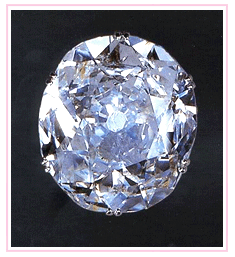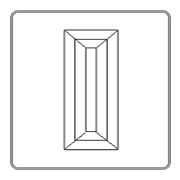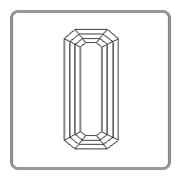CHOOSING A DIAMOND- CHECKING 4 C's
Clarity describes the clearness or purity of a diamond. This is determind by the number, size, nature and location of the internal (inclusions) and external( blemishes) imperfection.

Colour describes the amount of colour the diamond contains.This can range from colourless to yellow with slight tints of yellow, gray or brown. Fancy cplours are also available that are not therfore more valuable.
Cut refers to the proprtions, finish, symmetry, and polish of the diamond. These factors determine the fire and brilliance of the diamond.
Carat is the unit of weight for the diamond. A carat is further subdevided in 100 points (0.01 carat = 1 point). One carat is equal to 0.02 grams. Value per carat increases with carat size, because larger rough diamonds occur less frequently.
Colour The "colour" of a diamond refers to its degree of "yellowness." The ideal diamond is completely colorless, and therefore it will be the most expensive. The Gemological Institute of America (G.I.A.) grades color alphabetically from D (totally colorless) to Z (yellow):
For a diamond to be considered "colorless," the G.I.A. requires that it be a D, E, or F. However, the D-Z scale is continuous, so the difference between an F and G is very small. The average color for engagement diamonds in the United States is G to H.

Jewelers have two tools at their disposal to judge the color of a given diamond. The first is what's known as a "reference set" of stones. A jeweler will compare the stone in question with a set of stones of known color (the set is typically made of cubic zirconium!), and make a qualitative determination as to the color grading of the stone in question. The second, more precise method, is to use a colorimeter, which is nothing more than an electrical device that will measure the optical characteristics of the stone and report the color to within 1/3 of a grade. Be aware that most jewelers routinely "round up" the results of a color test. Therefore, a stone that is only slightly better than an F grade automatically becomes an E (and hence becomes more expensive for the consumer to purchase).
When judging the color of a diamond, it is crucial to see the diamond unmounted. Ask to see the printout from the colorimeter, or ask the jeweler for a reference set of stones to make the comparisons yourself. To do this, place the diamond in question next to the reference stones face down on a white piece of paper, and compare the color of the stones until you get the best match.
Cut
Cut is by far the most confusing of the 4 Cs, since it can refer to the cutting style, the shape of the stone (round, square, heart-shaped, etc.), its proportions, or the workmanship of the actual diamond-cutting process. Each of these four characteristics are important while evaluating a stone, so we will discuss each separately.
1. Cutting Style
Diamonds, as crafted by nature, consist of translucent crystalline carbon. If the outer rough could be peeled away, the resulting stone would be as smooth as glass; unfortunately, it would be no more aesthetically pleasing than a piece of glass crystal. The art of the diamond-cutter is to transform that chunk of crystallized carbon into a beautiful piece of jewelry.
The diamond-cutter has two basic types of cuts in his arsenal: The step cut and the brilliant cut. You may also hear of hybrids of the two basic cuts, such as the emerald cut, or you may also encounter some of the older-style cuts, such as the rose cut, the old European cut, or the old mine cut. If you are planning to purchase a diamond for a modern engagement ring, you only need to concern yourself with the two basic cuts.
The step cut has parallel facets that usually span the length or width of the stone. Refer to the picture shown here, and notice the "steps" that lead from the outer edges to the top of the diamond. If a step-cut diamond has rounded-off facets in the corners, this is a variant of the step-cut called the emerald cut.


The brilliant cut has triangular facets that surround the stone and usually culminate on a flat top called a table. Again, refer to the picture shown here and notice how the triangles fit into each other. The modern and popular brilliant-cut round engagement diamond has 58 of these triangular facets -- 33 above the middle of the stone (or the girdle), and 25 below.

Carat Weight
"Carat Weight" is simply the weight of the diamond. The following table shows, roughly, the appearance of different carat weights:

weigh less than 1 carat, the carat is usually subdivided into "points." There are 100 points in 1 carat, so that a diamond weighing 3/4 carat would be a "75 point diamond. In summary:
1 carat = 200 milligrams = 100 points Don't confuse the weight of a stone and its size. This argument is similar to that of cereal boxes or potato chips, where "contents are sold by weight, not volume." Also, don't confuse the carats of a diamond with the carats of a different stone. Because different minerals have different densities, a 1-carat diamond will have a different volume (a.k.a. size) than, say, a 1-carat ruby. Another common source of confusion: The karats used to measure the purity of gold have nothing to do with the carats used to measure the weight of a diamond. Notice the difference in spelling. If you're shopping for a diamond and you're unsure of a given stone's carat weight, simply ask the jeweler to weigh the stone in your presence. After making sure that the balance reports "0" when there is nothing on it, place the unmounted stone on the balance, take the number of milligrams reported by the instrument, and divide by 200 to get the carat weight of the stone.
Clarity
Clarity is a measure of the number and extent of the flaws in the diamond. Generally speaking, the fewer the flaws, the more valuable the diamond. Completely flawless diamonds are extremely rare -- only a few hundred "FL" diamonds are produced per year worldwide.
There are several grading systems used to describe clarity. By far, the most popular is the Gemological Institute of America's (G.I.A.) scale, which ranks diamonds as Flawless (FL), Internally Flawless (IF), very very slightly included (VVS), very slightly included (VS), slightly imperfect (SI), and imperfect (I):

between the different grades (what's the difference between "very very" slight and "very" slight anyway!):
FL: Completely flawless
IF: Internally flawless; only external flaws are present, which can be removed by further polishing the stone
VVS1 - VVS2: Only an expert can detect flaws with a 10X microscope. By definition, if an expert can see a flaw from the top of the diamond, it is a VVS2. Otherwise, if an expert can only detect flaws when viewing the bottom of the stone, then it is a VVS1
VS1 - VS2: You can see flaws with a 10X microscope, but it takes a long time (more than about 10 seconds)
SI1 - SI2: You can see flaws with a 10X microscope
I1 - I3: You can see flaws with the naked eye. Consider avoiding I2-I3 diamonds.
There are many different types of flaws. The best way to become acquainted with them is to look at lots of diamonds. The more common ones are as follows:
Pinpoint: A very small white dot on the surface of the stone. By far, the most common flaw
Carbons: A very small black dot on the surface of the stone. Less common than pinpoints
Feathers: Small cracks within the stone, similar in look to broken glass. Small internal feathers are harmless (other than lowering the clarity rating of the diamond), but large feathers can become a problem because the crack can grow as the diamond ages
Clouds: Hazy areas within the diamond, actually made up of many small crystals that are impossible to see individually
Crystal Growth: A small crystalline growth within the diamond. Looks like a small diamond within the big diamond
Unfortunately, clarity is very difficult to judge accurately by an inexperienced consumer, so your best bet is to gain an education first by looking at lots of diamonds before making a purchase. Any good jeweler will spend the time you need to get comfortable judging the clarity of your stone -- ask different jewelers to point out the flaws in several stones until you can detect pinpoints and other flaws by yourself.
